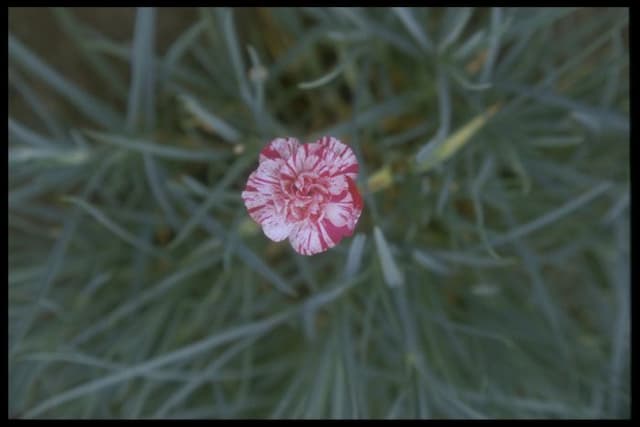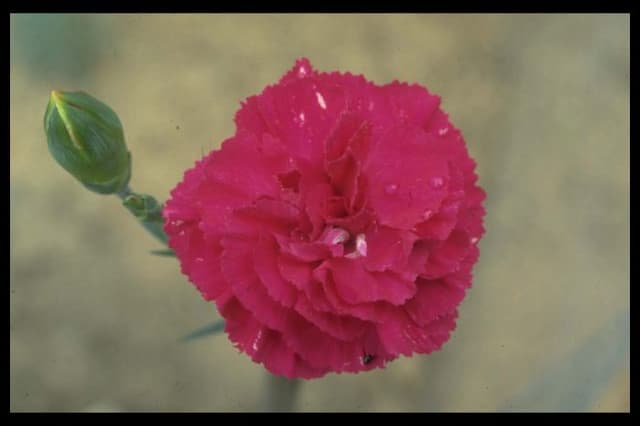Olivana Soapwort Saponaria × olivana

ABOUT
Saponaria × olivana, commonly known as the "Olivana soapwort," is a flowering plant notable for its beautiful and ornamental appearance. This perennial is distinguished by its lush, green foliage which forms a dense and spreading mat of foliage. The leaves are simple and ovate to lanceolate in shape, creating a backdrop for the blooms. During its flowering season, the Olivana soapwort produces clusters of petite, yet visually striking flowers. The flowers of the Olivana soapwort have a delicate charm, often coming in shades of pink or sometimes white, and are characterized by their five-petal structure which creates a star-like shape. These charming flowers are particularly attractive to pollinators such as bees and butterflies who are drawn to the blooms for nectar. Additionally, the blooming period of the Olivana soapwort contributes to its popularity as a garden plant, as it brings a splash of color when in flower. Overall, the Olivana soapwort presents a charming sight when used in rock gardens or as a ground cover, displaying a harmonious blend of green foliage with its soft-hued flowers that create a picturesque scene for any admirer or gardener.
About this plant
 Names
NamesSynonyms
Olivana Soapwort
Common names
Saponaria × olivana
 Toxicity
ToxicityTo humans
Saponaria × olivana, commonly known as soapwort, contains saponins which can be toxic to humans if ingested in large quantities. Symptoms of soapwort poisoning may include nausea, vomiting, diarrhea, and in severe cases, it can lead to hemolysis (destruction of red blood cells). It is important to avoid consuming any part of the soapwort plant due to these toxic properties.
To pets
Saponaria × olivana, known as soapwort, is also toxic to pets. The saponins present in the plant can cause similar symptoms of toxicity in pets as in humans. If a pet ingests soapwort, they may experience vomiting, diarrhea, and abdominal pain. In severe cases, hemolysis and systemic complications could occur. It is advisable to keep pets away from soapwort to prevent accidental ingestion.
 Characteristics
CharacteristicsLife cycle
Perennials
Foliage type
Deciduous
Color of leaves
Green
Flower color
Pink
Height
1 foot (30 cm)
Spread
1 foot (30 cm)
Plant type
Herb
Hardiness zones
Varies
Native area
Europe
Benefits
 General Benefits
General Benefits```html
- Attractive flowering: Saponaria × olivana, commonly known as soapwort, produces vibrant, eye-catching flowers that can enhance the aesthetic value of gardens and landscapes.
- Low maintenance: Soapwort is known for being easy to grow and requiring minimal care, making it suitable for gardeners of all skill levels.
- Drought tolerance: Once established, soapwort is relatively drought-tolerant, which is beneficial in areas with water restrictions or for environmentally conscious gardening.
- Wildlife attraction: The flowers of soapwort can attract pollinators such as bees and butterflies, which are essential for the pollination of many plants and the overall health of ecosystems.
- Ground cover: Soapwort can spread and cover ground effectively, which helps to suppress weeds and reduce garden maintenance.
- Erosion control: Its ability to spread and establish a dense cover can also be useful in stabilizing soil and preventing erosion on slopes or in areas prone to soil loss.
 Medical Properties
Medical PropertiesThis plant is not used for medical purposes.
 Air-purifying Qualities
Air-purifying QualitiesThis plant is not specifically known for air purifying qualities.
 Other Uses
Other Uses- Saponaria × olivana, commonly known as Bouncing Bet, can be used as a natural soap substitute due to its saponin content which creates a lather when combined with water.
- The plant's roots can be used in the production of halva, a traditional Middle Eastern confection, to create a frothy texture.
- Fiber artists use Bouncing Bet as a gentle detergent for washing wool and delicate fabrics to preserve their quality and texture.
- In historical reenactments, Bouncing Bet is sometimes utilized in demonstrating traditional cleaning methods and personal hygiene practices.
- Gardeners plant Bouncing Bet as a companion plant to attract beneficial insects that prey on garden pests, due to its nectar-rich flowers.
- The crushed leaves are used as a natural dye for fabrics, imparting subtle hues of yellow or green depending on the mordant.
- Bouncing Bet can be placed in closets or drawers as a natural insect repellent to protect clothing from moths.
- Photographers experimenting with historical processes use Bouncing Bet's saponins to create a natural solution for washing prints and negatives.
- As a result of its dense growth, Bouncing Bet is planted for erosion control in sloped gardens or banks.
- The plant is used in permaculture design as part of greywater treatment systems to break down and clean soapy water from households.
Interesting Facts
 Feng Shui
Feng ShuiBouncing Bet is not used in Feng Shui practice.
 Zodiac Sign Compitability
Zodiac Sign CompitabilityBouncing Bet is not used in astrology practice.
 Plant Symbolism
Plant Symbolism- Purity: Saponaria, commonly known as "Soapwort," is often associated with cleanliness and purity due to its historical use as a soap substitute.
- Love and Affection: As with many flowers, Soapworts are sometimes used to represent love and fondness in the language of flowers.
- Survival and Resilience: Given its ability to thrive in various environments, Soapwort can symbolize the capacity to survive and adapt.
 Water
WaterBouncing Bet, also known as Saponaria × olivana, should be watered deeply to ensure the water reaches the root zone, usually about 1 inch of water per week, either from rainfall or supplemental watering. During hot, dry periods, increase watering to twice per week. It's best to water early in the morning to reduce evaporation losses. Overwatering should be avoided as this plant does not like to sit in waterlogged soil; ensure that the soil is moist but well-drained. Depending on the size of your plant and the environmental conditions, you may need to adjust the gallons of water used but always aim to keep the soil consistently moist, not soggy.
 Light
LightBouncing Bet thrives best in full sun to partial shade; however, it prefers at least six hours of sunlight per day. Place the plant in a location where it can receive plenty of bright light but is protected from the harsh midday sun, especially in hotter climates. A spot with morning sunlight and afternoon shade would be ideal for promoting healthy growth and bloom production.
 Temperature
TemperatureBouncing Bet does well in a range of temperatures and can survive winter lows down to around -30°F, making it suitable for USDA hardiness zones 3 through 9. The ideal temperature range for promoting growth is between 60°F and 75°F. Extreme heat can be damaging, so provide shade or extra water if temperatures consistently exceed 85°F.
 Pruning
PruningPruning Bouncing Bet is important to maintain its shape and encourage bushier growth. After the plant blooms, cut back the flower stems to promote a second bloom in late summer or early fall. Pruning should be done annually, immediately after the first flowering cycle. Dead or damaged stems can be removed at any time to keep the plant looking tidy.
 Cleaning
CleaningAs needed
 Soil
SoilBouncing Bet hybrids like Saponaria × olivana prefer well-draining soil with a mixture of loam, sand, and compost. Aim for a slightly alkaline to neutral pH of around 6.5 to 7.5 for optimal growth.
 Repotting
RepottingBouncing Bet hybrids such as Saponaria × olivana do not need frequent repotting; once every 2 to 3 years is usually sufficient to refresh the soil and accommodate root growth.
 Humidity & Misting
Humidity & MistingBouncing Bet, or Saponaria × olivana, is tolerant of a wide range of humidity levels, making it a versatile garden plant. Aim for average humidity conditions without the need for specific adjustments.
 Suitable locations
Suitable locationsIndoor
Place in bright light, not too dry, minimal care needed.
Outdoor
Full sun to partial shade, well-drained soil, naturalize easily.
Hardiness zone
3-9 USDA.
 Life cycle
Life cycleThe life cycle of Saponaria × olivana, commonly known as Bouncing Bet or Soapwort, begins with seed germination, which requires a period of cold stratification to break dormancy. After germination, seedlings establish themselves and grow into vegetative plants with a basal rosette of leaves. As the plants mature, they produce erect stems and at maturity, they bear clusters of pink to white flowers during the summer months, which are attractive to pollinators. Following pollination, the flowers develop into capsules containing numerous tiny seeds. The seeds are dispersed by various means, including water and animals, and can remain viable in soil for several years. The plant may also propagate vegetatively through its root system, spreading to form dense clumps.
 Propogation
PropogationPropogation time
Spring-Early Summer
Saponaria × olivana, commonly known as the Bouncing Bet hybrid, is often propagated through division, a popular method favored for its simplicity and effectiveness. The best time to undertake division is during the cooler months of spring or fall when the plant is not in active growth. To propagate by division, gently dig up an established Bouncing Bet hybrid clump and use your hands or a sharp spade to separate it into smaller sections, each with a good portion of roots attached. Replant the divisions at the same depth they were originally growing, spacing them about 12 to 18 inches (30 to 46 centimeters) apart to allow enough room for growth. Water the new divisions well to help establish them. This method allows for the proliferation of mature plants that will resemble the parent plant in form and flower.




![Pink [Coconut Sundae]](/_next/image?url=https%3A%2F%2Fplants-admin.emdemapps.com%2Fimages%2Fplants%2F%2Fimages%2F604b5d09d4fd1.png&w=640&q=75)




